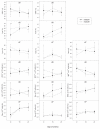Analysis of leukocyte populations in Canadian Holsteins classified as high or low immune responders for antibody- or cell-mediated immune response
- PMID: 23024458
- PMCID: PMC3314438
Analysis of leukocyte populations in Canadian Holsteins classified as high or low immune responders for antibody- or cell-mediated immune response
Abstract
Selection of dairy cattle for increased milk production with little or no emphasis on health traits leads to an increased prevalence of disease. A possible genetic solution to this problem is to combine production and immune response traits in a weighted selection index. In the current study, leukocyte populations in heifers identified as having a high antibody-mediated immune response (HiAMIR) or high cell-mediated immune response (HiCMIR) phenotype were compared before and after immunization in order to identify leukocyte population profiles associated with these phenotypes. The results demonstrated that the HiCMIR-phenotype animals had a higher baseline proportion of gamma-delta T-cells in peripheral blood. Also, the observed increase in the proportion of B-cells in peripheral blood in response to immunization was greater in the HiAMIR-phenotype animals. It is expected that identifying leukocyte population profiles associated with immune response phenotypes will improve our ability to identify animals with enhanced overall immune responsiveness.
La sélection des bovins laitiers pour une production laitière augmentée avec peu ou pas d’emphase sur les caractéristiques de santé peut mener à une augmentation de la prévalence de maladies. Une solution génétique possible à ce problème est de combiner les caractéristiques de production et de réponse immune dans un indice de sélection pondéré. Au cours de la présente étude, on a comparé les populations de leucocytes retrouvées chez les taures identifiées comme ayant un phénotype pour une forte réponse immunitaire à médiation par les anticorps (HiAMIR) ou une forte réponse immunitaire à médiation cellulaire (HiCMIR) avant et après immunisation afin d’identifier les profils de populations leucocytaires associées avec ces phénotypes. Les résultats ont montré que les animaux avec un phénotype HiCMIR avaient une proportion plus élevée au départ de lymphocytes T gamma-delta dans le sang périphérique. Également, l’augmentation observée de la proportion de lymphocytes B dans le sang périphérique en réponse à une immunisation était plus grande chez les animaux de phénotype HiAMIR. Il est attendu qu’en identifiant les profils des populations leucocytaires associées avec les phénotypes des réponses immunitaires améliorera notre capacité à identifier les animaux avec une capacité de réponse immunitaire globale supérieure.
(Traduit par Docteur Serge Messier)
Figures


References
-
- Simianer H, Solbu H, Schaeffer LR. Estimated genetic correlations between disease and yield traits in dairy cattle. J Dairy Sci. 1991;74:4358–4365. - PubMed
-
- Van Dorp TE, Dekkers JC, Martin SW, Noordhuizen JP. Genetic parameters of health disorders, and relationships with 305-day milk yield and conformation traits of registered Holstein cows. J Dairy Sci. 1998;81:2264–2270. - PubMed
-
- Uribe HA, Kennedy BW, Martin SW, Kelton DF. Genetic parameters for common health disorders of Holstein cows. J Dairy Sci. 1995;78:421–430. - PubMed
-
- Wilkie B, Mallard B. Selection for high immune response: An alternative approach to animal health maintenance? Vet Immunol Immunopathol. 1999;72:231–235. - PubMed
-
- Mallard BA, Wilkie BN, Kennedy BW, Gibson J, Quinton M. Immune responsiveness in swine: Eight generations of selection for high and low immune response in Yorkshire pigs. Proc 6th World Congr Genet Appl Livest Prod; 1998. pp. 257–264.
Publication types
MeSH terms
Substances
LinkOut - more resources
Full Text Sources
